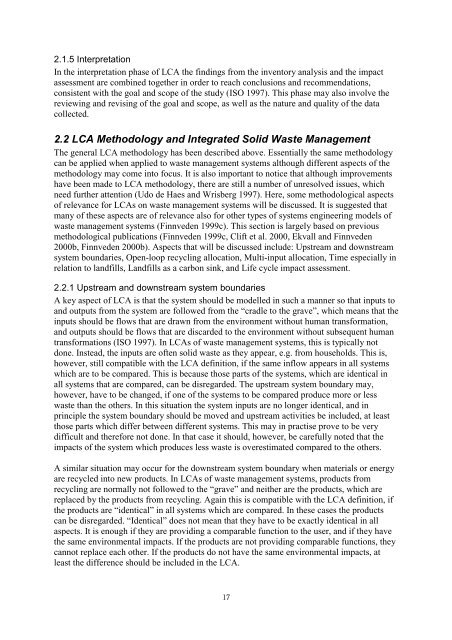Life Cycle Assessments of Energy From Solid Waste (PDF)
Life Cycle Assessments of Energy From Solid Waste (PDF)
Life Cycle Assessments of Energy From Solid Waste (PDF)
Create successful ePaper yourself
Turn your PDF publications into a flip-book with our unique Google optimized e-Paper software.
2.1.5 Interpretation<br />
In the interpretation phase <strong>of</strong> LCA the findings from the inventory analysis and the impact<br />
assessment are combined together in order to reach conclusions and recommendations,<br />
consistent with the goal and scope <strong>of</strong> the study (ISO 1997). This phase may also involve the<br />
reviewing and revising <strong>of</strong> the goal and scope, as well as the nature and quality <strong>of</strong> the data<br />
collected.<br />
2.2 LCA Methodology and Integrated <strong>Solid</strong> <strong>Waste</strong> Management<br />
The general LCA methodology has been described above. Essentially the same methodology<br />
can be applied when applied to waste management systems although different aspects <strong>of</strong> the<br />
methodology may come into focus. It is also important to notice that although improvements<br />
have been made to LCA methodology, there are still a number <strong>of</strong> unresolved issues, which<br />
need further attention (Udo de Haes and Wrisberg 1997). Here, some methodological aspects<br />
<strong>of</strong> relevance for LCAs on waste management systems will be discussed. It is suggested that<br />
many <strong>of</strong> these aspects are <strong>of</strong> relevance also for other types <strong>of</strong> systems engineering models <strong>of</strong><br />
waste management systems (Finnveden 1999c). This section is largely based on previous<br />
methodological publications (Finnveden 1999c, Clift et al. 2000, Ekvall and Finnveden<br />
2000b, Finnveden 2000b). Aspects that will be discussed include: Upstream and downstream<br />
system boundaries, Open-loop recycling allocation, Multi-input allocation, Time especially in<br />
relation to landfills, Landfills as a carbon sink, and <strong>Life</strong> cycle impact assessment.<br />
2.2.1 Upstream and downstream system boundaries<br />
A key aspect <strong>of</strong> LCA is that the system should be modelled in such a manner so that inputs to<br />
and outputs from the system are followed from the “cradle to the grave”, which means that the<br />
inputs should be flows that are drawn from the environment without human transformation,<br />
and outputs should be flows that are discarded to the environment without subsequent human<br />
transformations (ISO 1997). In LCAs <strong>of</strong> waste management systems, this is typically not<br />
done. Instead, the inputs are <strong>of</strong>ten solid waste as they appear, e.g. from households. This is,<br />
however, still compatible with the LCA definition, if the same inflow appears in all systems<br />
which are to be compared. This is because those parts <strong>of</strong> the systems, which are identical in<br />
all systems that are compared, can be disregarded. The upstream system boundary may,<br />
however, have to be changed, if one <strong>of</strong> the systems to be compared produce more or less<br />
waste than the others. In this situation the system inputs are no longer identical, and in<br />
principle the system boundary should be moved and upstream activities be included, at least<br />
those parts which differ between different systems. This may in practise prove to be very<br />
difficult and therefore not done. In that case it should, however, be carefully noted that the<br />
impacts <strong>of</strong> the system which produces less waste is overestimated compared to the others.<br />
A similar situation may occur for the downstream system boundary when materials or energy<br />
are recycled into new products. In LCAs <strong>of</strong> waste management systems, products from<br />
recycling are normally not followed to the “grave” and neither are the products, which are<br />
replaced by the products from recycling. Again this is compatible with the LCA definition, if<br />
the products are “identical” in all systems which are compared. In these cases the products<br />
can be disregarded. “Identical” does not mean that they have to be exactly identical in all<br />
aspects. It is enough if they are providing a comparable function to the user, and if they have<br />
the same environmental impacts. If the products are not providing comparable functions, they<br />
cannot replace each other. If the products do not have the same environmental impacts, at<br />
least the difference should be included in the LCA.<br />
17
















